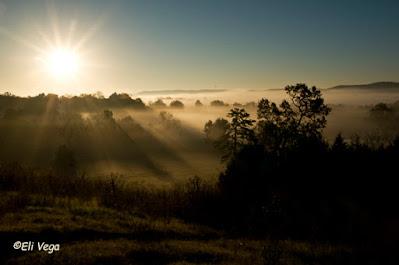PRIMARY COLORS
If we study color theory, we learn about something called The Color Wheel. On the color wheel, we will see the 3 primary colors: Red, Blue, and Yellow. If we mix red with blue we get purple; if we mix blue with yellow we get green; if we mix yellow with red we get orange--the secondary colors. If we keep mixing primary colors with secondary colors we get tertiary colors.
When we see the complete color wheel, we see what looks like a 12-piece pie, with cooler colors on the left and more vibrant, exciting colors on the right.
I keep these relationships in mind when I'm out shooting. The combination of colors gives me certain moods, which I often translate to a photograph. The end results, though not for all images of course, are soothing, calming images or exciting, vibrant images.
My tip, and assignment, for this month is to introduce primary colors into out images. They can be either the primary color in the scene, or they can be part of the image. The key is that they are evident in the image--Red, Blue, or Yellow.
With that introduction, I will now share images where I introduced primary colors, which is my tip of the month. They might not all evoke a feeling of tranquility or excitement, but the gist of my tip this month is to think primary colors.
This scene, though extremely interesting, had very little color. Most of the color in the scene was bland--grays, browns, deep greens, other dark colors, and then there was this one red umbrella that one of the men was holding. There was a light drizzle that day.
For this image, I converted the image to B&W, except for the red umbrella. The eye can't help but be drawn to it.
The colors in this image are not at all peaceful and tranquil.
In this image, taken at an Asian Dragon Festival, the predominant color is primary red, with primary yellow and the secondary colors of purple and green. Beautiful assortment of color on these umbrellas.
Yellow! It jumps out at you from this sunflower turninig itself toward the sun for health and nutrition. I shot it from behind. When I do that, knowing that the built-in light meter is going to darken the flower, I always override the meter by overexposing the image from what the meter thinks I need. In this case, I overexposed it by a + 2 & 2/3!!! Don't be afraid to override that undependable light meter, even when you're shooting manual exposure. My primary go-to exposure mode is A, or Aperture Priority.
I like to photograph subjects that most of us take for granted; subjects that may be considered mundane.
Believe it or not, this is under a city car bridge, in Boulder, Colorado. Someone painted a mural on the bridge support. There is a walking/jogging path toward the lower part of the scene. I decided to hop over puddle so I could get to the other side to pick up the relection of the wolf in the puddle.










